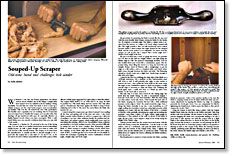Souped-Up Scraper
Old-time hand tool challenges belt sander
Synopsis: Kelly Mehler’s former apprentices all rave about how he tunes up a cabinet scraper, the old metal-body kind with spokeshave-like handles and a reputation for not working. Once you learn how to handle this scraper, you can take wide, fine shavings off any hardwood with ease, especially highly figured wood with cross-grain. Mehler tells you how to prepare the blade, remove the burr, turn over a hook on the cutting edge, and set the thumbscrew. He closes with some advice on using a scraper.
Whenever I run into my former apprentices, I’m always curious about whether any of the things I taught them have turned out to be valuable tools for making a living. Invariably, I’m told that one of the best tricks is how to tune-up a cabinet scraper—not the steel hand scrapers most woodworkers are familiar with, but the old metal-body ones with spokeshavelike handles and a reputation for not working. But I’ve found that once you learn how to handle this scraper, you can take wide, fine shavings off any hardwood with ease; it’s especially effective on highly figured woods where you have cross-grain. With a welltuned blade, you can smooth a tabletop faster than you can with a belt sander.
My scraper is a Stanley No. 80, pictured at the top of the facing page. You can order it or a similar version from most woodworking supply houses. As with a plane though, you want to make sure your tool has a flat, smooth bottom. The scraper, as it comes from the manufacturer, is usually not flat or smooth enough to do a good job. My scraper has a sole that’s 3 in. by 2 in., so it’s not much of a job to flatten and polish the sole with a piece of fine silicone carbide paper supported by a glass plate or other flat surface. The scraper blade itself is 2 in. wide and 2 in. long. It’s held in position by a flat metal clamp and two screws. The only other part is a thumbscrew that bears against the blade to keep it from chattering and to flex it. The more the screw flexes the blade, the heavier the cut.
I started using this scraper years ago when it seemed I was sanding all the time and getting sick of the dust and noise. I also don’t think a sanded surface finishes as well as a scraped one. I did a lot of reading to see how other craftsmen handle the problem and decided these old cabinet scrapers, which traditionally were used for smoothing after planing, offered a lot of possibilities. Many craftsmen are reluctant to use them, perhaps because of the perceived difficulty in tuning the tool: It’s more complex than sharpening a plane blade or chisel, because it requires forming a hook, which does the scraping, on the blade edge after the blade has been sharpened. At first, I couldn’t get the tool to work well. It took awhile to master the technique of getting the correct combination of bevel angle, straight edge and hook angle.
From Fine Woodworking #74
For the full article, download the PDF below:
Fine Woodworking Recommended Products

Veritas Wheel Marking Gauge

Suizan Japanese Pull Saw

Marking knife: Hock Double-Bevel Violin Knife, 3/4 in.





















Log in or create an account to post a comment.
Sign up Log in